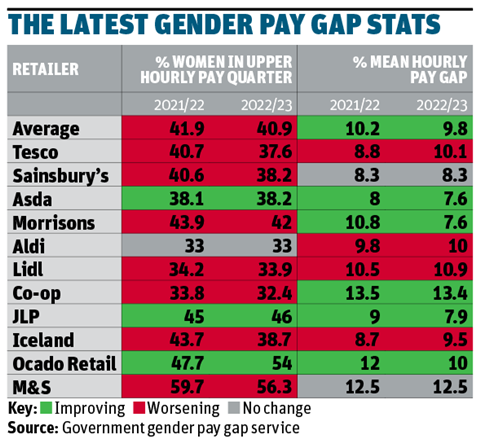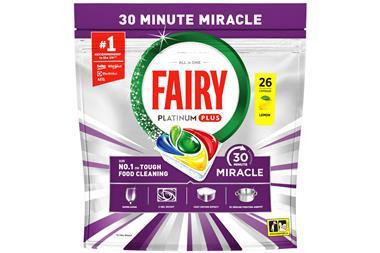
Female representation in higher-paid hourly roles at the supermarkets has fallen in the wake of sector-specific labour challenges, latest gender pay gap figures suggest.
Across the UK’s 11 biggest grocery retailers, representation of women in the top hourly pay quarter slipped from 41.9% in 2021/22 to 40.9% in 2022/23.
The average was brought down by seven retailers at which the percentage of women in the top pay quarter fell: Tesco, Sainsbury’s, Morrisons, Lidl, Co-op, Iceland and M&S.
Diversity in Retail founder Tea Colaianni pointed to companies responding to a tight labour market with premium salaries for roles “which are traditionally held by an overwhelming majority of men”, such as drivers and bakers.
Both Tesco and Sainsbury’s acknowledged the trend was partly down to investment in pay for drivers, the majority of whom are male.
At Tesco, representation of women in the top pay quarter fell from 40.7% to 37.6%, while at Sainsbury’s it went from 40.6% to 38.2%.
The newly filed gender pay gap reports to the government also reveal the average hourly pay gap rose at four: Tesco, Aldi, Lidl and Iceland.

Nevertheless, on average the mean hourly pay gap decreased across the 11, from 10.2% to 9.8%.
“While the latest reporting for the grocery retailers shows overall progress in the right direction, it is disappointing to see the representation of women in the upper hourly pay quarter slip back,” said Colaianni.
She said companies needed to remove barriers to women returning to work after having a child, including “the introduction of family friendly and flexible workplaces, equalising parental leave, and providing affordable childcare”.
“The motherhood penalty is recognised as the most significant driver of the gender pay gap,” she explained.
“What is needed is a significant effort to introduce policies and practices that enable women to come back to work sooner and continue to progress their career.
“This data also shows leaders need an unwavering and long-term commitment to delivering change.”
A Tesco spokeswoman said: “We are working hard to drive female representation across all areas of our business. Since we first started reporting in 2017, we have made significant progress in reducing our gender pay gap and we remain well ahead of the UK average. While there is still work to do, we are moving in the right direction, and we are absolutely determined to build on the progress we have made so far”.
A Sainsbury’s spokeswoman said: “While we are pleased with the progress we have made to close the gap, we recognise we need to keep working hard to improve representation at senior levels and we are committed to driving inclusion across the business.
“We continue to improve our female representation at senior level and we are proud to now have a 50/50 gender split on our operating board.”
Read more: The 10 most powerful women in British supermarkets
M&S – which despite a slight decline has the highest representation of women in the upper hourly pay quarter, at 56.3% – put the drop partly down to many in its predominantly male warehouse workforce moving into the top pay quarter thanks to an earlier than usual pay rise. It also said a higher proportion of women were sacrificing salary to buy extra holiday, as well as making pension contributions.
An M&S spokeswoman said: “While we have been ahead of the national average and continue to make progress, we know there is more to do. Our focus is making M&S a great place to work for women and we’ve since launched our industry leading Worklife offering, Job Share Finder and now have a female majority Board following the appointment of Cheryl Potter.”
Co-op said movement in the make-up of its upper pay quarter was principally down to a reduction in headcount.
A Co-op spokesman said its mean pay gap was “primarily due to more men being employed in a higher paid store manager roles, compared to women who are primarily employed in customer team member roles”.
“We are committed to addressing the gap and have established diversity objectives for all areas of the business and introduced a new ‘Inclusive Hiring’ training programme to ensure that all our hiring managers are mindful of how bias can affect the recruitment pipeline,” a spokesman added.
An Aldi spokesman said: “We will become the first supermarket in the UK to pay our Store colleagues a minimum of £11.40 an hour later this year and our rates are based solely on a colleague’s role and length of service.
“We have decreased our overall gender pay gap significantly since records began in 2017 but we know there is still lots of work to do. That is why continuing to bring down our gap, and further improving equality at all levels of our business, is fundamental to our comprehensive and ongoing diversity and inclusion programme.”
Read more: The 10 most influential women in the world of discounting
A Lidl spokeswoman said: “Our fixed salary structure means colleagues are paid equally based on their role rather than their gender. This enables us to maintain equal pay across our business and we are proud that Lidl is leading the industry with a median gap of 0.0%.
“We’re also pleased to have a mean gender pay gap well below the average across the retail sector. However, we must do more to tackle any imbalance and we are committed to making further improvements – particularly in the higher pay quartiles. That’s why women in leadership are a key focus within our inclusion strategy for 2023.”
FTSE Women Leaders CEO Denise Wilson said: “As with many other industries, there remains much more to be done before seeing a real reduction in the pay gap in the retail sector.
“The key to closing the gender pay gap is in significantly increasing the number of women appointed to senior, high paid roles, removing bias from the selection process and creating a more female-friendly work environment.
“Until organisations tackle these underlying issues, and there is more collective effort in support of equal parenting and affordable childcare, further reductions in the pay gap will be a challenge.”



















No comments yet